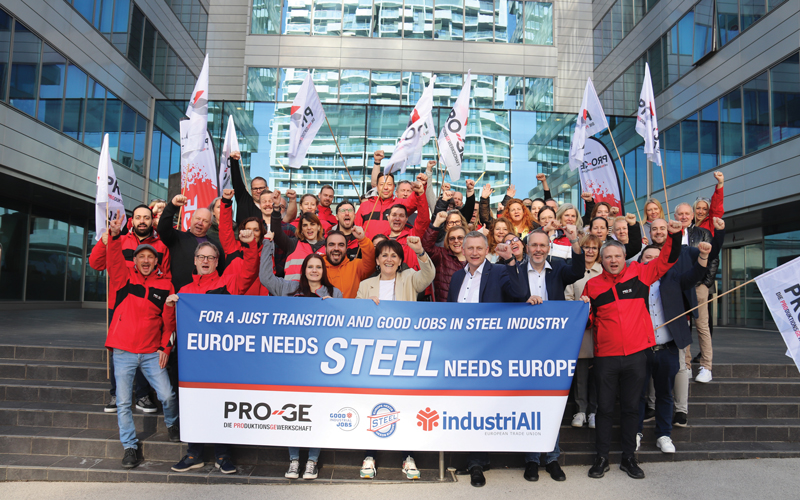Green steel in Europe needs an industrial deal in Europe
European steelworkers demand action for a just transition to green steel. A coordinated industrial deal is crucial to secure jobs, decarbonise steel and ensure Europe’s strategic autonomy, says Judith Kirton-Darling, General Secretary of IndustriALL Europe.

On 21 March, green smoke rose from the blast furnace at Tata Steel in IJmuiden, the Netherlands, as steelworkers across Europe mobilised to demand a just transition to green steel.
Steel is a strategic sector for Europe, at the root of the energy, construction, automotive and defence industries, and employing 300,000 workers. A strategy for green steel is not only urgent for the climate, but also to stimulate investment and innovation to keep European manufacturing competitive, maintaining and creating good industrial jobs. In a volatile geopolitical context, strategic autonomy in the steel supply is crucial.
An industry in crisis
The urgency has been intensified by Covid-19, war in Ukraine, and rising energy and raw material prices. Europe’s steel production has plummeted to 2009 levels, with market share lost to imports from third countries resulting in the loss of more than 25% of direct steel jobs since the financial crisis in 2008–09. This is staggering given that one direct job in the industry brings in six indirect jobs.
However, the situation is different elsewhere. Steel overcapacity had increased to around 2.5bn tonnes by the end of 2023, according to the OECD. China has increased production capacity by 2.2%, India by 7.5%. And more than half of new capacities (2024–26) will be based on traditional blast furnaces. European steel is decarbonising in a hostile environment.
We are at a critical juncture. Half of Europe’s blast furnaces will need to be replaced before 2030 due to their age. Investment decisions are needed in the coming months, but the current scale of industrial ambition risks deindustrialisation in Europe. Based on public data from the Green Steel Tracker and the Global Energy Monitor, complete decarbonisation projects from European steel companies (announced, and representing an industrial transformation, regardless of their status) currently represent a total capacity of 54 million tonnes (mt) annually. Meanwhile, Europe has existing nominal capacities of 97.5mt in primary steel production and 86mt in iron. Relatively few of these green steel projects have reached final investment decisions, and investment uncertainty is increasing anxiety among steelworkers.
The path forward: investment and innovation
Governments have a crucial role to play in securing the framework conditions for these investments and security for workers in transition. Strategic autonomy will come at a price, but deindustrialisation costs more. According to the European Steel Platform, “new, low-CO2 steel production technologies will require an investment of approximately €50–60bn, with €80–120bn/yr capital and operating cost”. Electricity consumption is set to rise by 60% between now and 2030 (notably in sectors such as the steel industry), and the European Commission (EC) estimates that €584bn of investment will be needed this decade to modernise grids. Austerity measures could exacerbate the risk of deindustrialisation in Europe.
Securing a just transition
We need a coordinated industrial policy to drive green steel demand (through public procurement and lead market initiatives), secure raw materials and ramp up the circular economy, and deliver infrastructure to ensure abundant affordable energy. Trade policies must ensure a level playing field during the transition. Public support and funding will be key, but there need to be social strings attached to deliver a just transition for workers, promoting collective bargaining, worker participation and job guarantees. This would provide a ‘return for taxpayers’ in good jobs and community investment. IndustriALL Europe and Eurofer have advocated for this.
The clock is ticking
In response to these concerns, EC President Ursula von der Leyen committed to a Clean Industrial Deal in the first 100 days of the new EC mandate. As steelworkers across Europe have been saying, “steel needs Europe, and Europe needs steel!”. We have a short window in which to get this right.






Follow us
Advertise
Free e-Newsletter